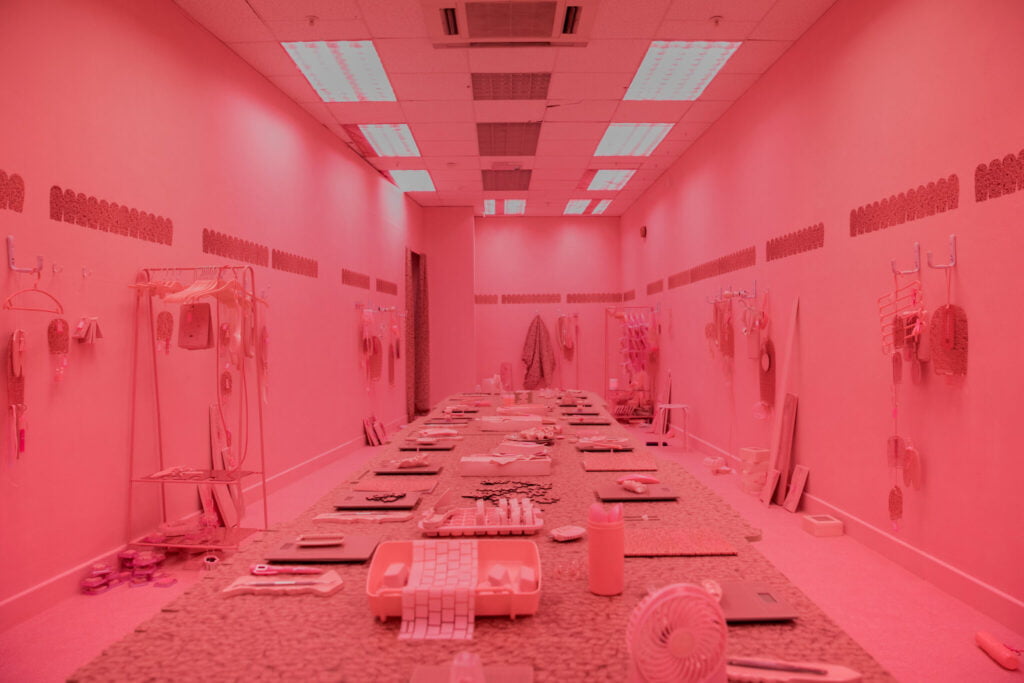
Sarah Roberts, ‘Clod_di’
The Leeds Summer Group Show is an annual exhibition started by Courtney Spencer started in 2015. This year she partnered with Leeds Inspired, CuratorSpace and The State Of The Arts to present the 2020 exhibition online in response to the unusual set of circumstances. From almost 400 submissions, the selection panel chose 38 artists to exhibit and awarded six shortlisted artists/collectives with a share of the £600 cash prize and, luckily for our readers, an interview on The State Of The Arts! The artists are: Sarah Roberts, Paris Crossley, Nisa Khan, Katie Bennett-Rice, Alice Chandler and ACCA.
Below is the first of our series of interviews: in this one we chatted with an artist obsessed with surfaces and collecting – Sarah Roberts.
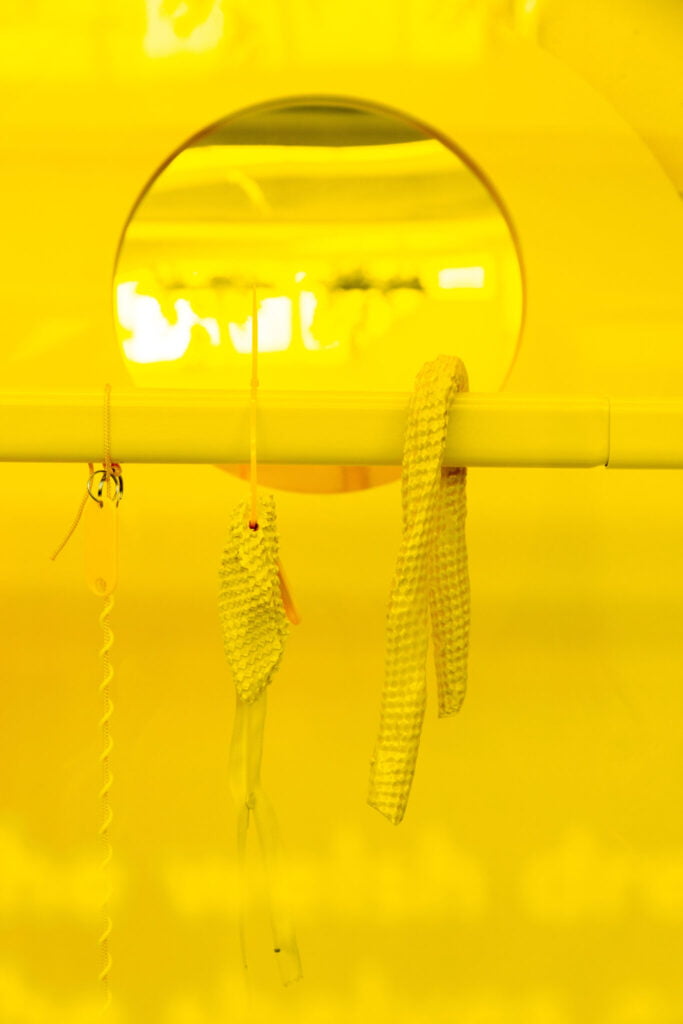
Sarah Roberts, ‘Everything’s mustard’
What are the main themes running through your work?
My practice centres around the actuality of the surfaces of the world – from casino carpets to the curve of a back or a cliff edge – any thing is fair game. I am obsessed by landscape, architecture, and the panoply of objects we spend our lives navigating, collecting, making and making sense of as bodies. And the point of interest for me is the intrinsic materiality of stuff, of making ‘sense’ of things in terms of their tactility and their actuality. We live in a world of hyper reality where everyone seems to keep talking about everything disappearing – but the way I see it we are constantly accosted by ever increasing multiplicities of STUFF.
As a maker, and the daughter of a hoarder I have a love-hate relationship with materiality, I find myself obsessed with collecting and using materials but also terrified of the impact of amassing, of adding to the pile of undoable things. I am a self-confessed material junkie maker, living in the age of the anthropocene.
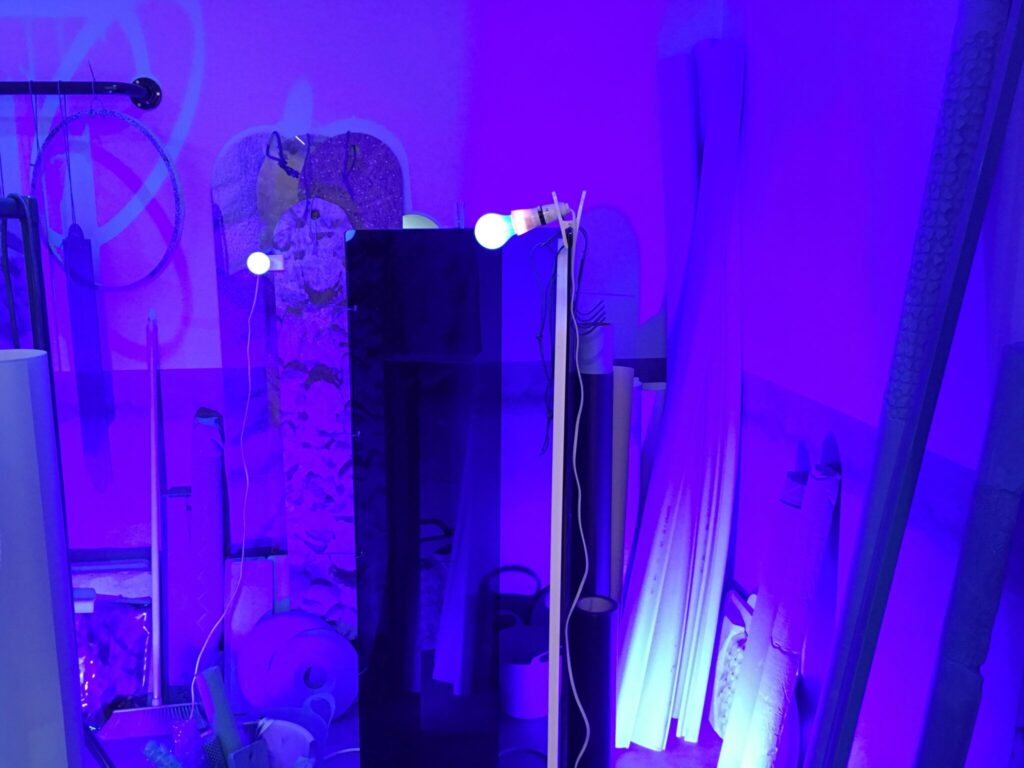
Sarah Roberts, ‘Partial plastic oasis’
What were the first artworks/ artists/ experiences that made you want to create art yourself?
I’d love at this point to recollect some wonderful childhood memory of an afternoon at the Royal Academy with my parents or such, but I can’t. I grew up in mid-Wales in a village where the nearest art gallery was quite a drive away and not even on my radar. I got told to do French instead at school for an easier ‘A’ and as a teenager I was more interested in cider than Cézanne.
There was an inkling of interest though. I used to draw a lot as a kid, loved copying things, and was obsessed with collecting rocks, shells, souvenirs and the like from the local pound shops and arcades. I would assemble them in curated clutches around the house, and the net curtained windows on the prom with the boats in bottles, shell constructions and Royal Doulton Figurines were like catnip. I still have a thing for seaside windows. When I was living in London I’d make pilgrimages to the coast and painstakingly document the best net curtain galleries.
I didn’t really see a lot of shows as an adult either, I didn’t really think about art. I became quite interested in photography in my twenties though, and then had a weird moment in New York with my friend Anna. We saw a William Eggleston retrospective and gate-crashed a crit that was happening at the Whitney Biennial by accident. I honestly decided then and there to apply to art school at 29, I quit my job and moved to London to study at Chelsea.
I think coming to it all late was amazing, there was no expectation, and everything was new and mind blowing. I think all the side step moves I’d made to get here counted, from the French GCSE to the Sociology BA – I ended up in the right place at the right time as a sum of all my parts.
Since the epiphany I can’t get enough in terms of seeing art: my most mind blowing experiences have to be Phyllida Barlow’s RIG, Mike Nelson’s ‘The Coral Reef’ and Thea Djordjaze’s amazing installation ‘As Sagas Sa’ in the Greenhouses at Documenta 13 in Kassel. All of these works give you that complete immersion that for me is what art is all about.
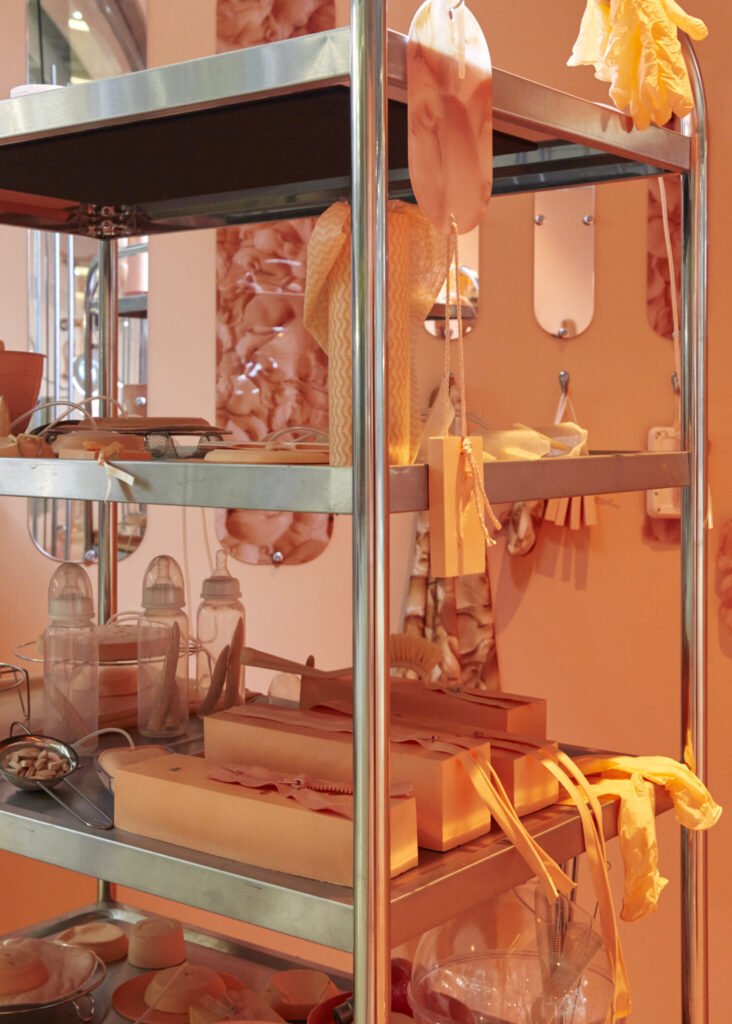
Sarah Roberts, ‘Peach melba’
Tell me about the significance of colour in your work.
I use colour in the same way I use excess, to encourage a real sort of ‘looking’ at objects. The overdone repeat or excess creates a space for the uncanny. Things become a set of ‘objects’ made anew whilst rooted very much in the quotidian experience and in real materials. If everything is washed in a uniform colour we start to question the ‘things’ that are normally accepted as part of the everyday. In these uncanny assemblages value is also questioned, where a cast cheese grater can sit alongside a ceramic dental pick or a fake flower, all equivalent, the everyday and the art object collided. You obviously can’t separate form from colour, but you can use colour to highlight it and hopefully to question the bizarre lines we draw around, above and below, and between things.
When researching, I collect images of walls, floors, things – zooming in on the surface so they are all texture, colour or form. The distilling of colour starts here. I think it’s notable that I don’t see it as a reduction to colour, texture and form – it’s more like making it visible.
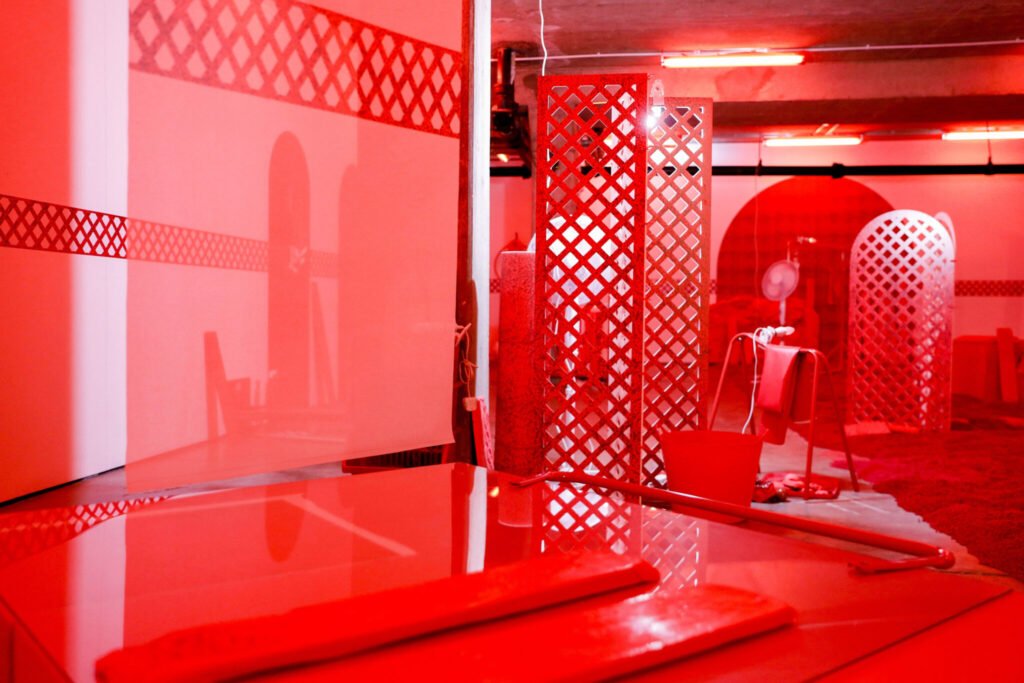
Sarah Roberts, ‘Torremolinos-Tableaux-Tongue-Twister (After Sun)’
The images are repeated into forms, poured into plasters, smoothed into ceramics and printed on various substrates with sliding scales, sound, scents and more. For each place, the representation I create is led by the overall sensation of that place as I record it and colour really helps. Sometimes places seep into a singular hue, other times their apparent colour blocks stick out shouting.
And let’s not forget that colour has a connotation that for everyone can be a little different, it’s guiding and unifying but has a space within it for the viewer to make it their own.
How has art and making accompanied you through the pandemic so far? Has it helped in any way or has your relationship to it changed?
When lockdown started, I didn’t feel like making anything at all – I am in fact still mid-way through an installation piece called ‘Blue promise’ which is now defunct with no exhibition to go to (I WILL find it a home when things are safer). The idea of putting people at risk to go to the studio to finish an artwork with nowhere to go seemed mad, so I didn’t go to the studio and instead created a workspace at home. In fact I did loads of DIY, it felt really good to be doing things that felt useful and lasting.
When I did get a space up and running as a home studio there were suddenly practical restrictions on making work (lack of space, being able to throw materials around freely) but I also felt myself being held back by something else. As I described previously I’ve long since been in a weird love hate relationship with my practice around the use of so much material within it, I can normally justify this if the work is set to be exhibited. So the idea of making ‘stuff’ just for the sake of making felt a bit weird in a time of crisis. On the flipside – not making was making me feel rubbish and frustrated.
Then came the amazing Matthew Burrows and his #Artists Support Pledge, a lifeline for artists via Instagram. Not only did this give me a platform to sell some work, it gave me a really good reason to make some. I started doing a collage every couple of days with a corresponding text – it felt amazing to have something to work towards and to be connected again to the wider network I was missing.
Virtual shows were also great for keeping me sane, like the Leeds Summer Group Show, giving artists a chance to connect with an audience whilst physical spaces were off limits, and giving us the chance to keep viewing.
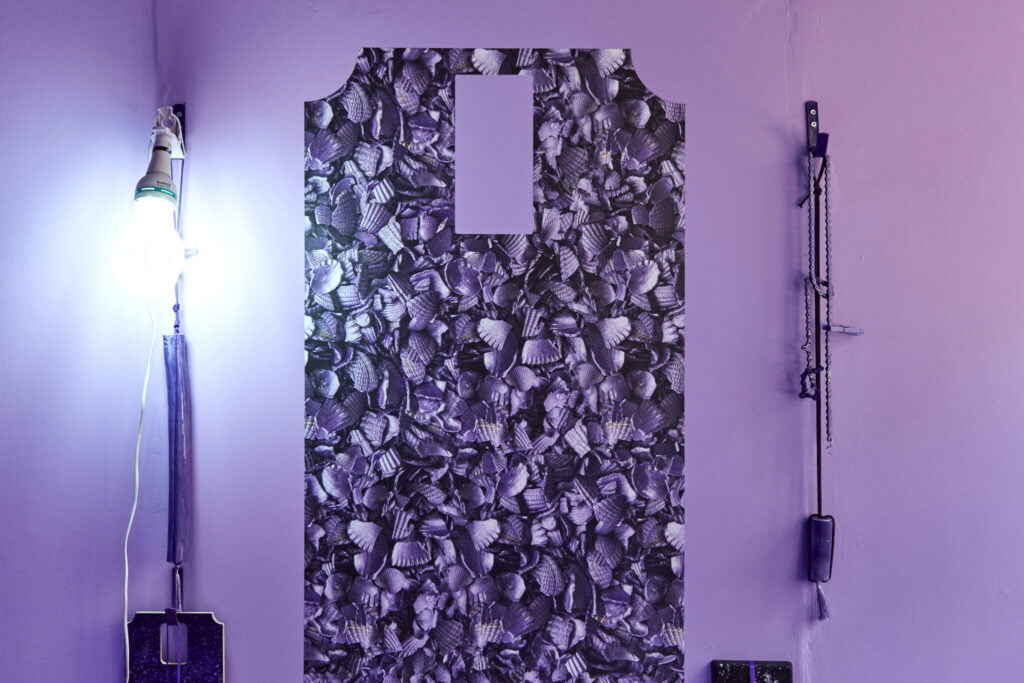
Sarah Roberts, ‘The colour purple’
I think the new normal has changed me a bit, its forced me into areas I wasn’t confident in – I am writing every day, trying out new techniques and focusing on translating my practice as best I can – sometimes it can be good to be shaken up. I really miss making installations though and I don’t see that love affair being over so easily – I can’t wait to get back to it, it’s how I naturally articulate.
What’s the purpose of art?
It’s an essential way of seeing.
It’s a compulsion.
What is your main source of inspiration at the moment?
I would normally make research trips like pilgrimages to places of particular material interest. Each place provides a palette and resultant installation, I’ve previously devoured and spat out Torremolinos, Hong Kong, Borth in North Wales, Reno Casinos to name a few.
I was supposed to go to Dubai in March and was super excited about this majorly constructed reality I was about to grab up as a palette to work from and with. But that was quickly off the cards of course, and any sort of immersion in ‘other’ places and spaces is not so easy even now, months later.
So instead I’m turning to old photographs from my late mother’s cardboard box archives, and leafing through the plethora of interior design books, DIY magazines and the Reader’s Digest guides to natural wonders I have been collecting up for the last ten years from car boot sales and second hand shops. To be honest, the ‘new normal’ is making so many things alien that that in itself is interesting too. The idea that we used to all get into cloth cubicles and sweat all over jumpers in the local Zara is off the wall, but I’m still ruminating on all that.
Take a look at Sarah’s website here: www.sarahrobertsfa.com and her Instagram account here: @sarahrobertsfa
Filed under: Art & Photography
Tagged with: art, artist, collecting, colour, courtney spencer, hoarding, interview, leeds summer group show, sarah roberts, stuff, things
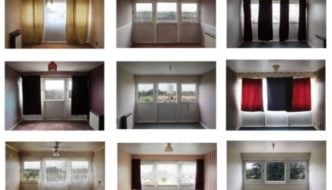
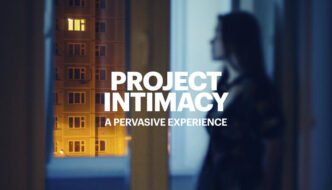
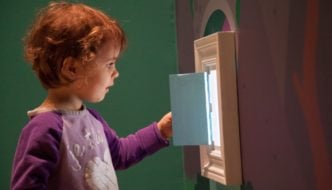
Comments